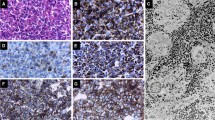Abstract
Pituitary adenomas producing almost exclusively growth hormones (GH) have been ultrastructurally classified into two distinct types: densely granulated somatotroph (DG) adenomas and sparsely granulated (SG) adenomas. Fibrous body (FB), an intracytoplasmic globular aggregation of cytokeratin (CK) filaments, is a hallmark of SG adenomas. Under light microscope, FB could be identified by CK immunohistochemistry as a dot-pattern immunoreaction versus a perinuclear pattern for cells without FB. However, it has been noted that numerous adenomas contain mixed populations of the two patterns. To clarify clinicopathological characteristics of the adenomas with mixed populations (“intermediate type” adenomas) and to confirm clinicopathological differences between strictly defined DG-type and SG-type adenomas, we performed this study on 104 GH cell adenomas. Having segregated “intermediate-type” adenomas (26 cases), we found significant differences between typical DG-type (47 cases) and SG-type adenomas (31 cases); SG-type adenomas had younger ages (44 vs. 50), higher frequency of macroadenomas (86% vs. 58%), invasiveness (65% vs. 38%), advanced grades (3 or 4) in Knosp’s classification (50% vs. 24%), and weaker immunoreaction for GH, β-TSH, α-subunit, E-cadherin, and β-catenin. Clinicopathological characteristics of “intermediate-type” adenomas were identical to those of DG-type adenomas. These findings confirm that SG-type adenoma is a distinct section of GH cell adenomas with special properties and biological behavior, and suggest that intermediate-phenotype adenomas are enrolled in DG-type adenomas. Special properties and biological behavior of SG-type adenomas may appear after the majority of tumor cells possess a fully developed fibrous body.







Similar content being viewed by others
References
Asa SL. Tumors of the pituitary gland. In: Rosai J, ed. Atlas of tumor pathology (Third Series Fascicle 22). Washington DC, PA: Armed Forces Institute of Pathology, pp. 47–149, 1998.
Horvath E, Kovacs K. The adenohypophysis. In: Kovacs K, Asa SL, eds. Functional endocrine pathology. vol 1. Boston, PA: Blackwell, pp. 245–81, 1991.
Kontogeorgos G, Watson Jr RE, Lindell EP. Growth hormone producing adenoma. In: DeLellis RA, Lioyd RV, Heitz PU, Eng C, eds. Pathology and genetics of tumors of endocrine organs (Series of: World Health Organization Classification of Tumors). Lyon, PA: IARC Press, pp. 14–9, 2004.
Horvath E, Kovacs K. Morphogenesis and significance of fibrous bodies in human pituitary adenomas. Virchows Arch B Cell Pathol 27:69–78, 1978.
Neumann PE, Goldman JE, Horoupian DS, et al. Fibrous bodies in growth hormone-secreting adenomas contain cytokeratin filaments. Arch Pathol Lab Med 109:505–8, 1985.
Kasper M, Stosiek P, Van Muijen GNP, et al. Cell type heterogeneity of intermediate filament expression in epithelia of the human pituitary gland. Histochemistry 93:93–103, 1989.
Yamada S, Aiba T, Sano T, et al. Growth hormone-producing pituitary adenomas: correlations between clinical characteristics and morphology. Neurosurgery 33:20–7, 1993.
Sano T, Ohshima T, Yamada S. Expression of glycoprotein hormones and intracytoplasmic distribution of cytokeratin in growth hormone-producing pituitary adenomas. Pathol Res Pract 187:530–3, 1991.
Bando H, Sano T, Ohshima T, et al. Differences in pathological findings and growth hormone responses in patients with growth hormone-producing pituitary adenoma. Endocrinol Jpn 39:355–63, 1992.
Sano T, Yamada S, Hirose T, et al. Cytokeratin distribution and functional properties of growth hormone-producing pituitary adenomas. Endocr Pathol 5:107–13, 1994.
Mazal PR, Czech T, Sedivy R, et al. Prognostic relevance of intracytoplasmic cytokeratin pattern, hormone expression profile, and cell proliferation in pituitary adenomas of acromegalic patients. Clin Neuropathol 20:163–71, 2001.
Bhayana S, Booth GL, Asa SL, et al. The implication of somatotroph adenoma phenotype to somatostatin analog responsiveness in acromegaly. J Clin Endocrinol Metab 90(11):6290–5, 2005.
Hardy J. Transsphenoidal surgery of hypersecreting pituitary tumors. In: Kohler PO, Ross GT, eds. Diagnosis and treatment of pituitary tumors. Int Congress Series No. 303. Amsterdam: Exerpta Medica, pp. 179–98, 1973.
Knosp E, Steiner E, Kitz K, et al. Pituitary adenomas with invasion of the cavernous sinus space: a magnetic resonance imaging classification compared with surgical findings. Neurosurgery 33:610–7, 1993.
Xu B, Sano T, Yoshimoto K, Yamada S. Downregulation of E-cadherin and its undercoat proteins in pituitary growth hormone cell adenomas with prominent fibrous bodies. Endocr Pathol 13:341–51, 2002.
Sano T, Rong QZ, Kagawa N, et al. Down-regulation of E-cadherin and catenins in human pituitary growth hormone-producing adenomas. Front Horm Res 32:127–32, 2004.
Yamada S, Sano T, Stefaneanu L, et al. Endocrine and morphological study of a clinically silent somatotroph adenoma of the human pituitary. J Clin Endocrinol Metab 76:352–6, 1993.
Wick MR. Immunohistology of neuroendocrine and neuroectodermal tumors. Semin Diagn Pathol 17:194–203, 2000.
Scott MP, Helm KF. Cytokeratin 20: a marker for diagnosing Merkel cell carcinoma. Am J Dermatopathol 21:16–20, 1999.
Haas JE, Palmer NF, Weinberg AG, et al. Ultrastructure of malignant rhabdoid tumor of the kidney. A distinctive renal tumor of children. Hum Pathol 12:646–57, 1981.
Saito T, Oda Y, Itakura E, et al. Expression of intercellular adhesion molecules in epithelioid sarcoma and malignant rhabdoid tumor. Pathol Int 51:532–42, 2001.
Asa SL, Digiovanni R, Jiang J, et al. A growth hormone receptor mutation impairs growth hormone autofeedback signaling in pituitary tumors. Cancer Res 67:7505–11, 2007.
Acknowledgments
We would like to express our warm thanks to Ms. N. Amo, M. Fukatani, and E. Hisamoto for their kind technical assistance.
Author information
Authors and Affiliations
Corresponding author
Rights and permissions
About this article
Cite this article
Obari, A., Sano, T., Ohyama, K. et al. Clinicopathological Features of Growth Hormone-producing Pituitary Adenomas: Difference among Various Types Defined by Cytokeratin Distribution Pattern Including a Transitional Form. Endocr Pathol 19, 82–91 (2008). https://doi.org/10.1007/s12022-008-9029-z
Published:
Issue Date:
DOI: https://doi.org/10.1007/s12022-008-9029-z




